We have it easy (relatively speaking)
I say “we” meaning growers and retailers in North America, and I say “we have it easy” in comparison to your counterparts in Europe, with whom I just spent four days, courtesy of the big trade show IPM* Essen, which I attend every year for the chance to catch up with global trends.
Here, we’ve got some headwinds going into spring 2024: high interest rates, high labor costs and some general uncertainty about spring that seems to have some retailers hesitant to place orders with growers, who then are hesitant about placing their orders with the seed companies. And, of course, the weather. My advice? If you want to be up this year, grow superb crops, throw as little in the Dumpster as possible and sell your plants off.

In Europe, they’ve got the war in Ukraine—which doesn’t seem to affect day-to-day life outside of the war zone, but which always lingers in the back of the mind. They're not in a recession, officially, but GDP growth for the EU was only about 1% in 2024, compared to 2.5% for the U.S. Experts expect the EU to remain flat to slightly up in 2025. Inflation, meanwhile, is at about 2.4%, so there’s general economic malaise.
Energy costs have stabilized and become a bit more predictable, which is good news for growers who don’t have to choose between growing plants and selling their natural gas futures like they did in 2022. Natural gas is at around $14.40 a dekatherm in Germany. Checking our Henry Hub gas price, it’s at $3.27. Gas for my rental car was something like $8.50 a gallon. So cheap it’s not … but it’s at least stable, so growers can build in the cost.

Easy (continued)
You think you're taxed? In the EU, plastic has a big target on its back, with a new (2021) “plastic levy” in place to reduce the proliferation of non-recycled plastic waste—while also funding the 2021–2027 EU budget. I’m not quite sure how this affects plastics used by growers and retailers, but I did see one pot company, Desch Plantpak, introducing lighter-weight grower pots (because the tax is levied by weight—80 euro cents per kilogram). And they’ve got things like the Euro Plant Tray, the recently developed reusable shuttle tray, to get around the single-use plastic ban (which doesn’t yet target nursery and greenhouse, but could).
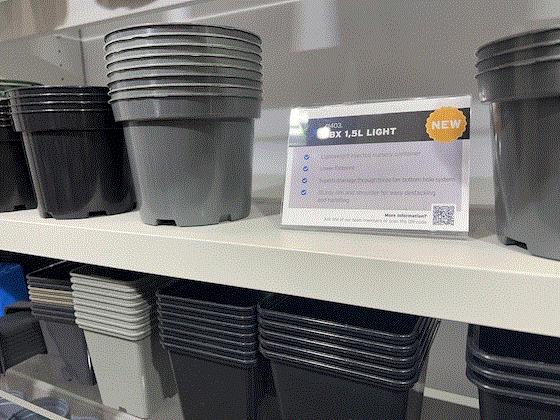
Lastly, regulations. Chemical pest controls and PGRs are all but gone, peat is under attack, and everything is getting measured in carbon footprint—in fact, a new law, the Corporate Sustainability Reporting Directive (CSRD), will require all companies with 250 or more employees and/or $41 million in revenues (and/or $21 million in assets) will have to track and report their carbon footprint. Even smaller companies will have to comply by 2028. But that seems to be the way of life in the EU; most folks embrace it, or shrug and accept it.
But like here, weather remains the make-or-break factor. Garden centers can thrive—visit one in late January as I did and the parking lot will be like Mother’s Day Weekend here. Inside it’s warm, it’s green, it’s colorful and lunch is served along with amazing coffee and pastries. Folks still love to garden in Europe, so like you, they’re counting on good weather come April, May and June.
*By the way, the “IPM” in IPM Essen does not mean integrated pest management (although there are plenty of exhibitors offering IPM tools, since chemical controls are just about gone). No, it means “Internationale Pflanzenmesse” … which basically means international plant fair—which is what it is, along with cut flowers, pots, soil, machinery, greenhouses and everything else you need to grow pflanzen.

Changes on the show floor
It’s a big show—the biggest horticulture trade fair in the world, with 1,400 exhibitors filling nine halls. But it’s not as big as it used to be, with entire categories like garden décor absent (not a birdhouse in the place) and with notable plant companies deciding not to show.
I heard that one major change was due to big gaps in the trade show floor. You see, there’s a basement area—Hall 1a it’s called—and many greenhouse and nursery folks never make it down there because it’s primarily floristry, along with some new variety displays and university research. This year, they moved all of that upstairs into Halls 4 and 5, which was good for the florists, who got to do their demos and show their designs in the light of day.
Replacing all of that in 1a was the German auction Landgard and something called “Ordertage:” a place where you could actually place orders for plants. Some 5,000 plants in 60,000 sq. ft. in hundreds of shapes, sizes and species, all perfect and ready to order for pickup at one of Landgard’s depots around Germany. If you’ve ever been to the cash-and-carry called Waterdrinker at the Aalsmeer auction, you know what it was like.
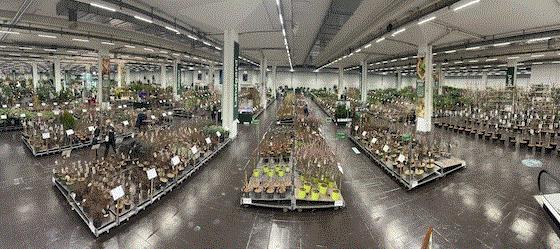
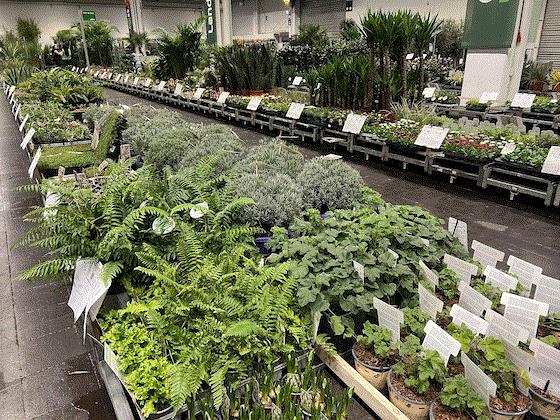
I read they had 150 German, Dutch, Italian and Danish growers represented, so it was a great one-stop-shop to see what European nursery and greenhouse product looks like—tremendous quality and variety!

You want plants!
With my TPIE coverage last week, I can pretty much guarantee that if I showed it to you, you can buy it. With IPM, not necessarily. However, since every global plant breeder, propagator and distributor attends the show, chances are, if it’s cool, somebody is looking to bring it to North America.
Cissus quadrangularis
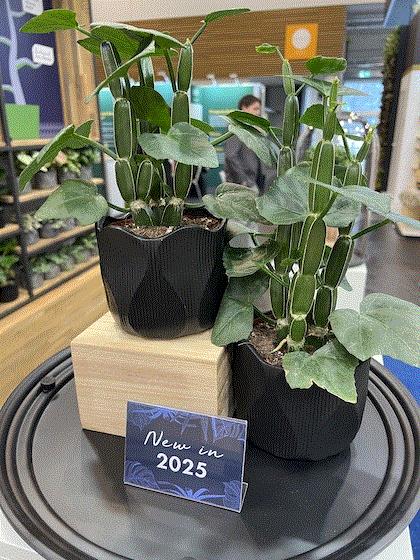
For instance, I spotted this cool specimen during my last hour of the last day: It’s a relative of good old grape ivy, named for its unusual square stems. It was in the Bunnik Creations booth and I know they have plant friends all around the world—in fact, some Americans were in the booth drinking coffee when I snapped this photo. Perhaps they were working a deal …
Hydrangea paniculata Groundbreaker
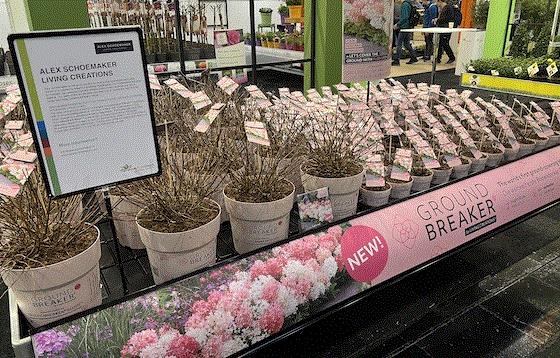
“The world's first groundcover hydrangea,” Groundbreaker comes from my friend Alex Shoemaker, a woody grower from the Netherlands whose stylish brand is called Living Creations. He says Groundbreaker only grows to about a foot tall, making it ideal for borders or in containers. It blooms for up to 100 days, from July through September, with flowers starting white then changing to pale pink then bright pink. It’s also super cold-tolerant, going down to -20F.
Peperomia Buenos Aires
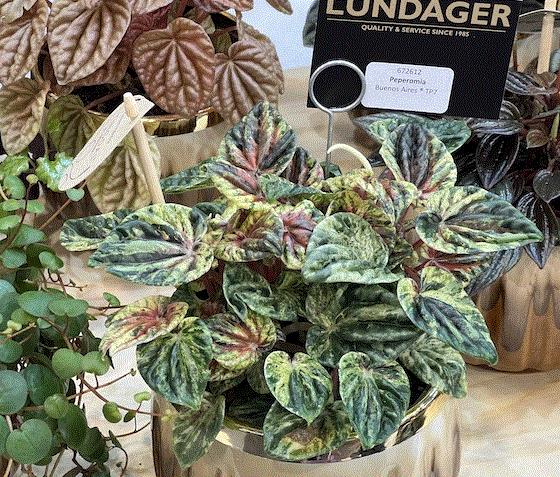
The Danes used to occupy all of Hall 5; now they take up the back section of it, but still I never miss it because they are the masters of small houseplants. Like this pretty peperomia called Buenos Aires in the Lundager stand. I made the mistake of showing its picture to Laurie; now she won’t rest until she gets this colorful specimen of the popular genus.

More plants
Asplenium antiquum Yuaspgio Gioia
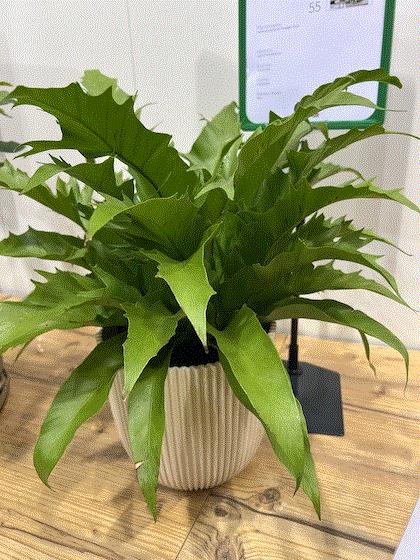
I spotted this one in the novelties competition area where it won the Foliage Indoor Pot Plants category. From Vitro Plus, this bird’s nest fern sports pointy, holly-like fronds. It’s only lacking one thing: a pronounceable cultivar name.
Windbell cyclamen
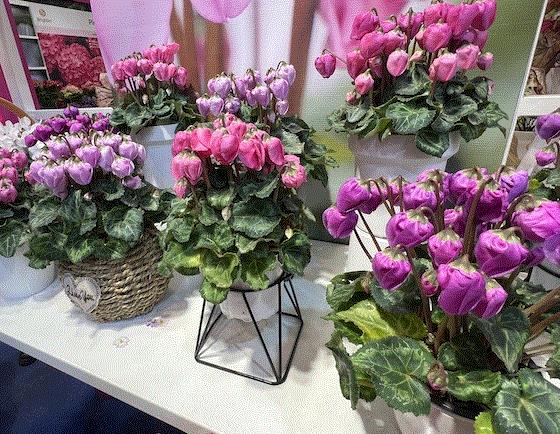
From breeder Brighten Floriculture in Hong Kong, this cyclamen series’ unique flower form caught everyone’s attention.
Fantasy Star Pink poinsettia
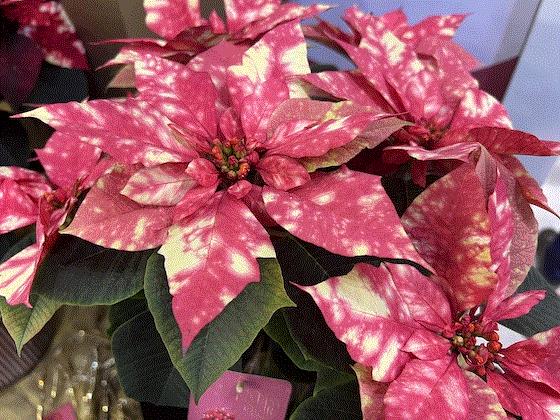
From Selecta One, the speckled poinsettias Fantasy Star Red and Orange are both available in North America. Will the new Fantasy Star Pink come this way, too? I don’t see why not …
Braided … crape myrtle?
You’ve probably seen braided willow before—living branches of willow that are shaped into all sorts of living garden structures and topiaries. Well, in the stand of GreenExport Group of Italy I saw magnificent braided topiaries made not from willow, but from azalea, crape myrtle and osmanthus.
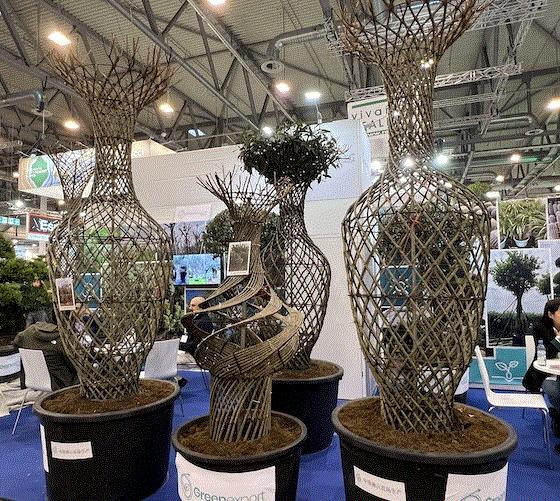
I was told that they're grown in China, they’re eight to 10 years old and they spend about 55 days on a slow boat to Italy where they leaf out in just a few months. Cost in China is only $380! But then there’s freight, etc., etc. … but they must be stunning in a big clay pot and in flower!
Labor-saving machines
My first stop at IPM is always Hall 3, where most of the equipment companies can be found. Sometimes there are breakthroughs, but, generally, I find tweaks to existing equipment that makes it a bit faster, smoother or more dependable.
Javo of the Netherlands upgraded an old design for a pot spacer that has no overhead structure, making it useful for tall plants, whether foliage or nursery stock. Called the Compact, the spacing forks pass under the conveyor belt when returning to pick up new plants, which saves time and makes for a compact footprint.
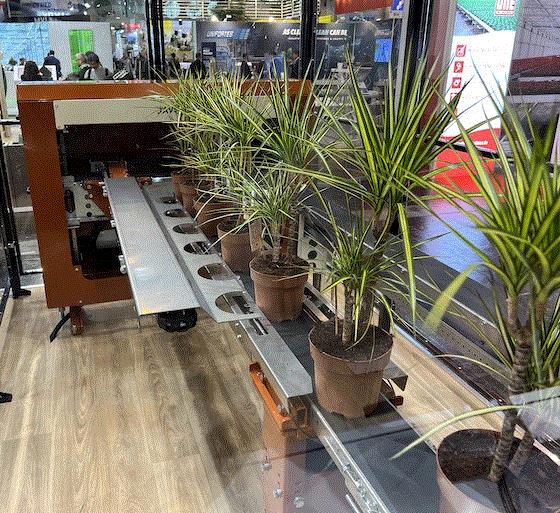
Germany’s Mayer, which makes some excellent carousel-style pot fillers, elongated the deck on the 7500 Filler to allow it to sit next to standard bedding plant transplanters. Capacity is 12,000 pots per hour.
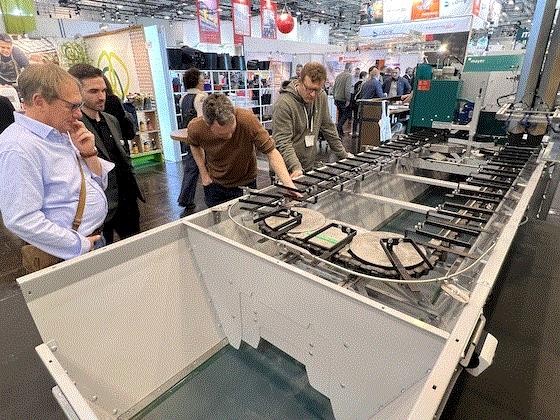
Italy’s Saiem Nursery Automation has designed a transplanting head that fits on a standard industrial robot. This monster, which has four planting heads, is designed for bumping up nursery stock—like 6-in. pots into 3 gal. or similar. They’re based in Modena, home of Ferrari.
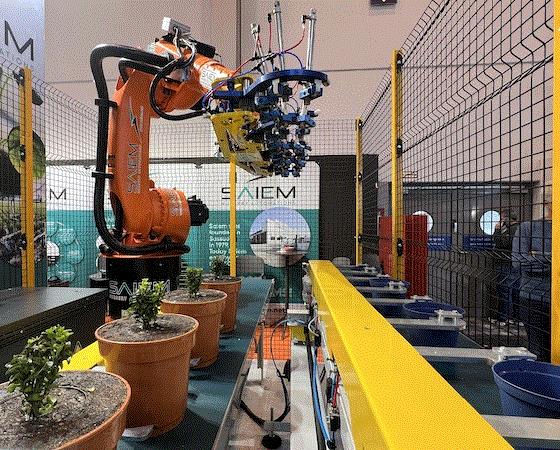

Innovative products
Selecta One quietly showed what could be a major innovation in offshore rooted cuttings: something they're calling RCS 2.0—for Rooted Cutting System. (They say the 2.0 after the name is because it’s a culmination of all that has come before it.)
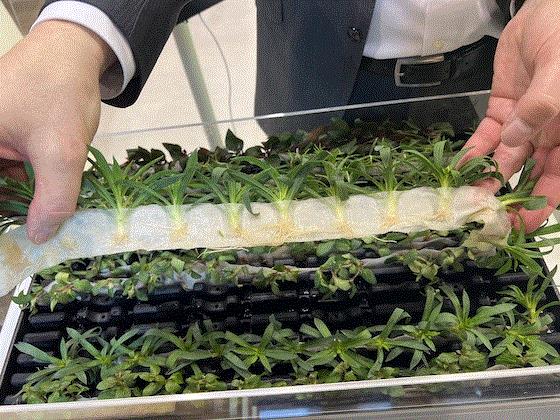
It’s vegetative cuttings rooted in the fold of a special piece of paper … it’s much like germinating seeds on a damp paper towel. Advantages are no plastic (biodegradable and environmentally friendly), and lightweight and compact (lower shipping cost). Available as strips or singulated, it can be planted with a robot cutting sticker like TTA or ISO or even by hand. I suspect there will be a machine to handle the strips straight from the trays.
Right now they’re being produced in Kenya for shipping to Europe. No word on potential availability in the U.S.
Meanwhile, Kent, Ohio-based Smithers-Oasis debuted an innovative new flower foam called Renewal that's completely plant-based—no petroleum products at all. However, florists can be assured it works and feels just like the Oasis foam they know and love.
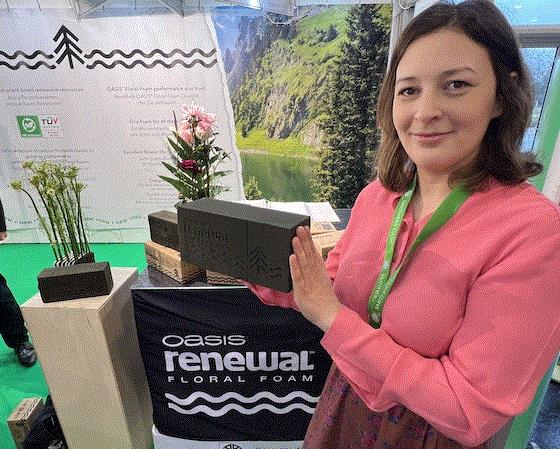
Its plant-based formulation has gotten a top certification by TUV Austria and its carbon footprint is 56% smaller than regular Oasis floral foam. It’s gray-green in color when dry and rich black when wet, so it blends into arrangements nicely. That’s Global Sustainability Manager Kristin Bienia showing it off.

Packaging ideas
I was disappointed this year to find very little new in plant packaging. We all grow the same stuff, and one way to differentiate is how you package and present your products. But I did find a couple of nice concepts:
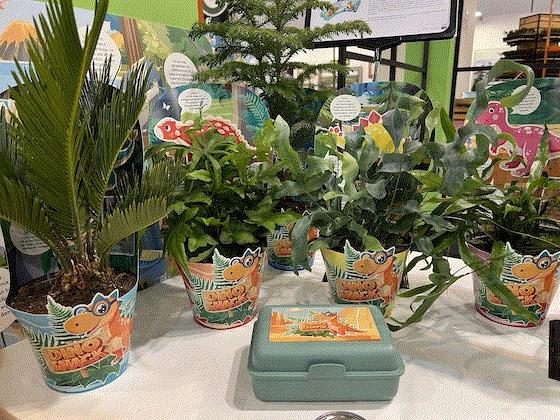
Something for the kids from German company Mediflora is Dino Snack, a line of exotic tropical plants in kid-capturing dinosaur-themed POP. Five different varieties—Cycas, Doryopteris, Auracaria, Microsorum and Phlebodium—presumed to be plants the dinosaurs liked to munch on.
About Plants Zunder, a cooperative of two nursery growers in the Netherlands, showed this colorful and informative packaging for their otherwise twiggy, nondescript trees. You see a lot of this at IPM—extremely colorful POP to sell plants with no leaves or flowers. They show what the consumer will get when the plant matures.
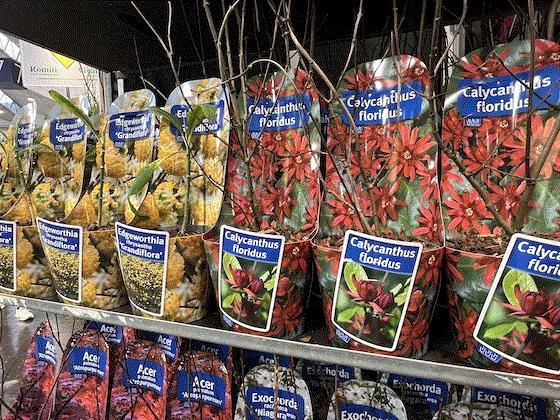
The IGOTY winners
I may no longer be the emcee of the event, but I’m still invited to attend and imbibe, which I did, so I could be on the spot when AIPH (the International Association of Horticulture Producers) named its International Grower of the Year during IPM Essen.
And the winner for 2025 is …
La Gaitana Farms, a Colombian carnation grower. La Gaitana also earned the top prize in the Cut Flower & Bulbs and Sustainability categories. That’s Camilo Bleier, owner and GM, accepting the Gold Rose from Daan de Vries, CEO of Headline Sponsor MPS. They join luminaries like past winners Costa Farms, Metrolina Greenhouses and Brookdale Treeland Nurseries, among others.

And the winner of the relatively new (fourth year) Young International Grower of the Year Award, organized by Jungle Talks, is David Marin of Colombia, a director at Deliflor Americas.
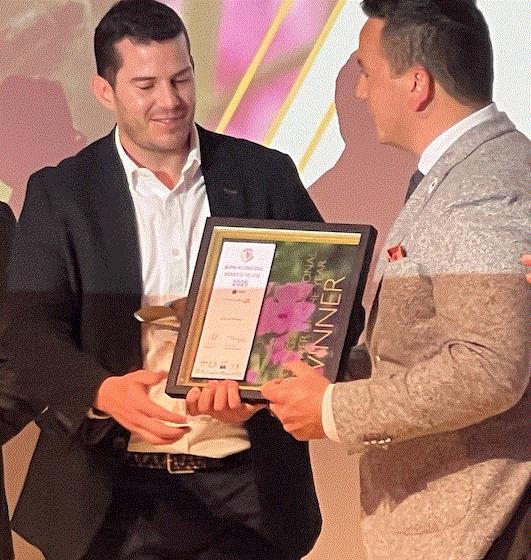
Finally I …
Speaking of awards, do NOT forget to sign up for OUR annual awards, the Young Grower Award and Young Retailer Award. They're for anyone age 35 or younger (as of July 15, the date of the prize presentation at Cultivate’25) who's making a career of our industry, either in growing or in retailing. You can nominate yourself, a friend, a family member, an employee, your boss (hint, hint)—anyone you think is worthy of the honor.

And an honor it is! We'll select three finalists for each award who'll be our guests at Cultivate’25 for a schwanky dinner with industry luminaries like Anna Ball. Then it’s off to Unplugged where we announce the winners to much hoopla. The winners each get the fame and fortune that comes from cover profiles in the September issue of GrowerTalks/Green Profit. And they become judges for next year’s awards.
Young growers, sign up HERE. Young retailers, sign up HERE. Act now, as you’ve only got until March 1.
A special thanks to our sponsors Ball Horticultural Company, The Garden Center Group and their Partners for Success, AmericanHort, and prize sponsor BASF. We can’t do it without you!

Finally II …
Last time, I wrote about the merger of automation companies TTA and ISO Group. I saw the CEOs of both at the new combined TTA x ISO booth and, curious, I asked them to reenact how they decided which company name came first:
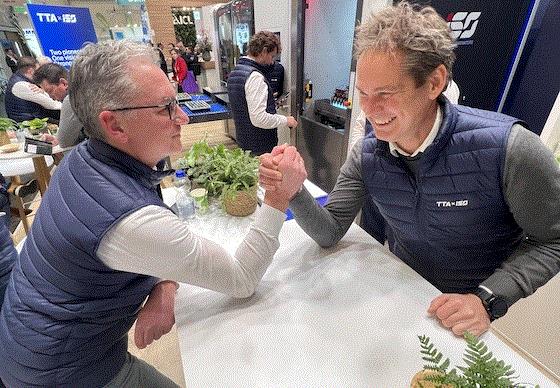
Kidding! Actually, it was easy, explained ISO CEO Martin Maasland (right, and looking confident): ISO is a terrible search term—all the results related to ISO 9002 and other International Organization for Standardization stuff. Because of that, he and TTA CEO Jan Bakker agreed TTA should go first.
And now you know the rest of the story.
Feel free to email me at beytes@growertalks.com if you have ideas, comments or questions.
See you next time!

Chris Beytes
Editor-in-Chief
GrowerTalks and Green Profit
This e-mail received by 29,690 loyal readers!
Thanks to my loyal sponsors, who help me reach the 29,690 readers of Acres Online in more than 60 countries. Want to be one of them (a sponsor, that is)? Give Kim Brown a shout and she will tell you about our many advertising opportunities.